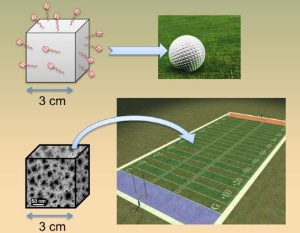Engineers from Vanderbilt University have developed a sponge-like silicon biosensor that can be used not only for medical diagnostics, but can also help detect tiny molecules and dangerous toxins in the environment.
This new silicon biosensor was basically designed to identify the existence of specific DNA sequences. The DNA sequences help identify whether a person is inclined to heart disease or other types of cancer.
The new silicon sensor is reported in Optics Express, the open access journal of Optical Society.
 Sponge-like biosensor stuffs tremendous power into small space
Sponge-like biosensor stuffs tremendous power into small space
Biological chemical sensors are designed to detect particular molecules in the blood or hazardous substances in the surroundings that pose threat to human life. The application of the existing sensor technologies is limited due to its large size since it is not possible to sense minute particles.
Sharon M. Weiss, an associate professor and Xing Wei, a graduate student from Vanderbilt University have reported in Optics Express that it is possible to create sensors that are considerably small since the particles detected are of molecular size, and this would ensure high sensitivity. In order to prove this fact, the engineers chose a porous silicon material that can behave as a tiny sponge whose pores can be filled with all kinds of particles that would change its properties resulting in a sensor that can detect small molecules conveniently.
The engineers stress the relevance of the surface area of their new sensors. Weiss has described two cubes, the first one is three cm on a side having a flat surface where DNA can be bound and the second one is a same-size cube shaped into a porous silicon sponge. The second cube provides about 10,000 times greater surface area because it can access the cube volume with all of its internal surface area compared to the first cube. By using a new type of exterior texturing of porous silicon or a grating, light can be used to analyze the change in the properties of the sensor to find whether any molecules have been detected or not.
Source: http://www.osa.org/